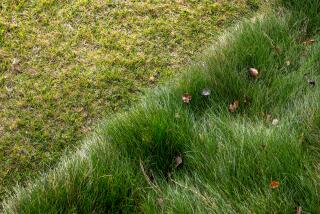Strategies for the Perennial Turf War
- Share via
Lawn care can be a labor of love or the bane of one’s existence.
For many, it’s a chore, and a confusing one at that. Few people have the time or inclination to learn all about turf grasses. So we blunder forward in a perpetual struggle for damage control.
It’s enough to make us long for a middle ground, where a few simple rules and a minimum of chemicals carry us happily from season to season.
Where you live has a lot to do with how you maintain your lawn. There are basically two types of turf grass in the United States. The northern three-fifths of the nation is dominated by cool-weather grasses, usually bluegrass or fescues, such as the creeping red or the tall fescue.
The southern one-fifth of the nation relies on warm-weather grasses, mostly Bermuda grass and Zoysia grass.
A transition zone supports both warm- and cold-weather grasses.
No wonder we’re so confused.
First, fertilize any grass to produce a healthy root system. If the roots are healthy, the top growth will be too.
While some stores recommend fertilizing several times a year, a late fall treatment with high nitrogen content is best for cool-weather grasses, which may include the lawns in coastal communities and higher elevations. In this case, half the mix activates immediately while the remainder is released over several months.
The best time for a fall fertilization is after you have put the lawn mower away. The goal is to build the root system while the top remains dormant. The root system remains organically active right up to when the ground freezes solid. By fertilizing in the spring, you produce more top growth instead of contributing to a healthier root system.
Warm-weather grasses, by contrast, produce peak top growth in the summer, so fall fertilizing is not very effective. With these grasses, fertilize in the early spring, just after dethatching. Water deeply after fertilizing to carry nutrients to the roots.
Tall fescues seldom need dethatching, but bluegrass, creeping red fescue and all warm-weather grasses should be dethatched yearly.
Thatch is a dense accumulation of dead plant matter that gathers at the base of the grass. As it builds, grass sends roots into it instead of the soil. In cool weather, the plant thrives in this nitrogen-rich substrata, but in warm weather, the thatch dries out, and the roots burn.
Rent a dethatcher each spring. Go over your lawn and remove the thatch that is turned up.
An aerator is similar to a rototiller, but instead of turning up the soil, it removes thousands of small soil plugs as you walk it over your lawn. By aerating the soil, the machine reduces weed growth because weeds grow best in compacted soil, while grasses thrive in uncompacted soil.
Holes poked through the turf provide a direct path for moisture and nutrients to reach roots, and the plugs of sod that are scattered over the turf quickly break down. This accelerates the return of the nutrients to the soil. Aerate and dethatch just before you fertilize.






